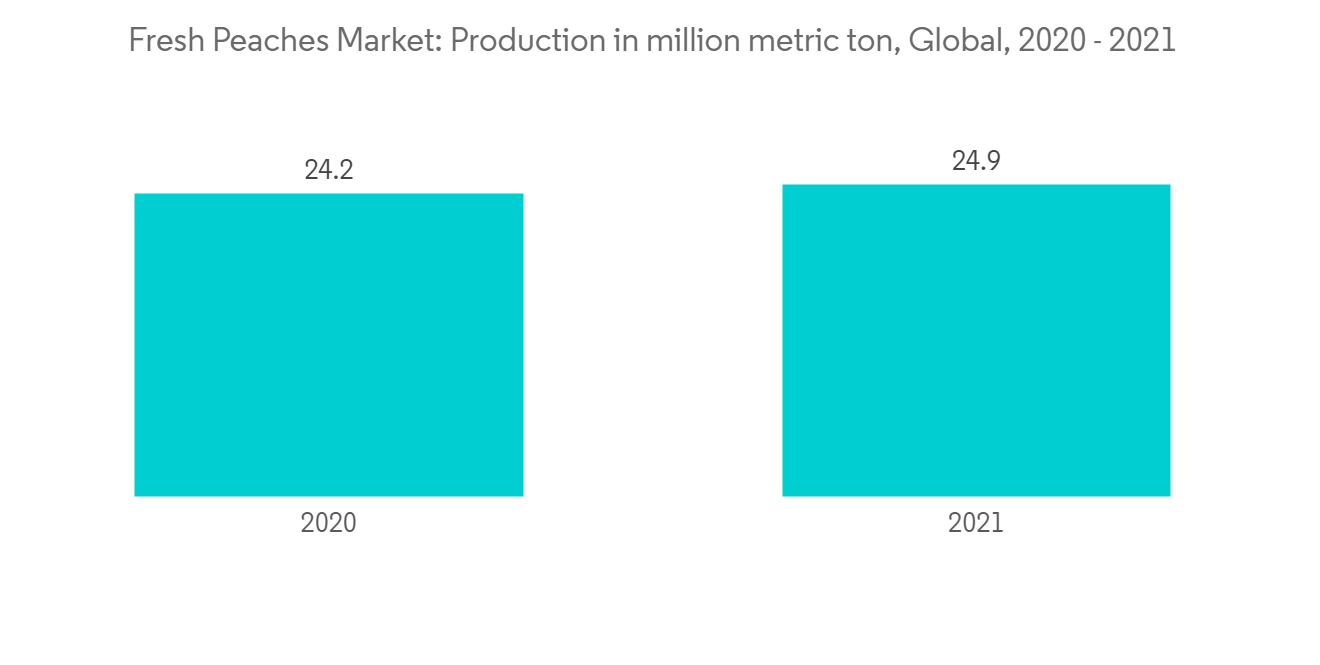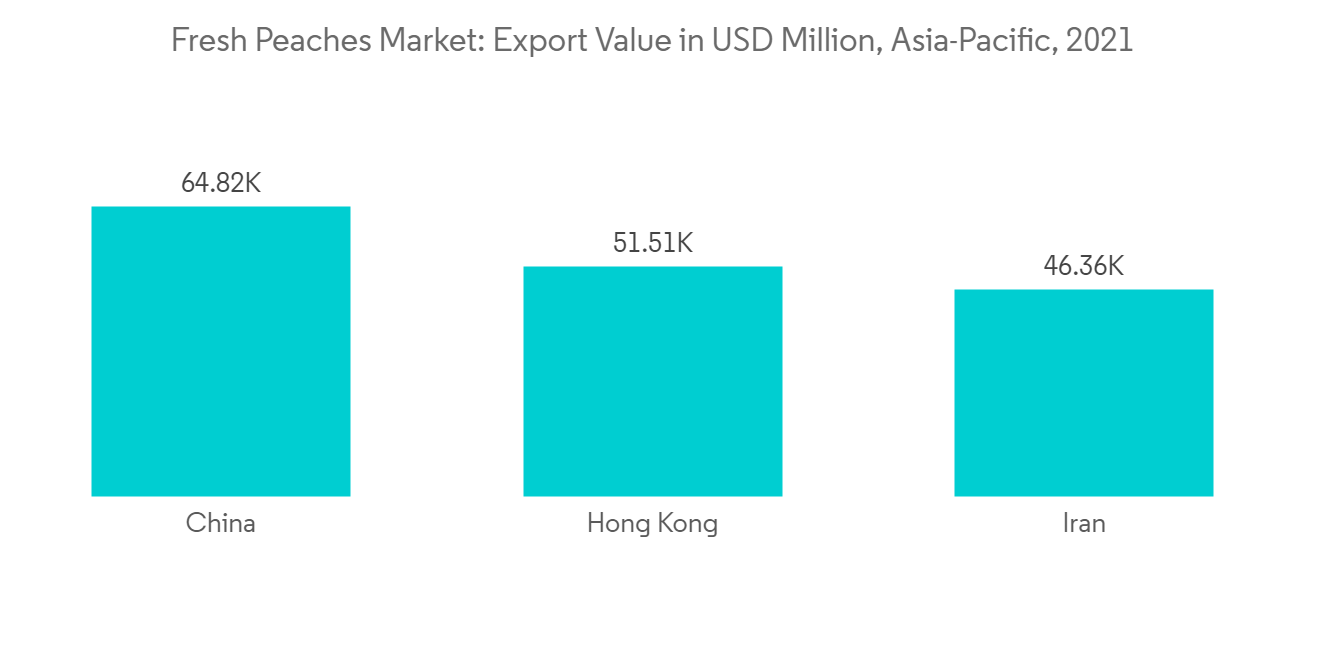 |
市場調査レポート
商品コード
1273337
生鮮桃市場- 成長、動向、予測(2023年~2028年)Fresh Peaches Market - Growth, Trends, and Forecasts (2023 - 2028) |
||||||
● お客様のご希望に応じて、既存データの加工や未掲載情報(例:国別セグメント)の追加などの対応が可能です。 詳細はお問い合わせください。
| 生鮮桃市場- 成長、動向、予測(2023年~2028年) |
|
出版日: 2023年04月14日
発行: Mordor Intelligence
ページ情報: 英文 95 Pages
納期: 2~3営業日
|
- 全表示
- 概要
- 目次
世界の生鮮桃市場は予測期間中にCAGR 3.2%で成長すると予測されます。
主なハイライト
- 新鮮な桃は、免疫力の強化、消化の改善、血圧のコントロール、慢性疾患のリスク低減など、さまざまな健康効果が期待できます。米国では黄肉種の桃が一般的ですが、アジア諸国では白肉種の桃が一般的です。
- オンラインショッピングは、北京の、中国とプロのチームは、農家が携帯電話で自分の桃を販売することを教え、地元の桃産業を近代化されたインターネットプラスビジネスに変換するために設定され、ますます人気が高まっているとしています。平匡全体のeコマース経由の桃の販売量は、2012年にはほぼゼロだったのに対し、2021年には2,500万kgに達しています。桃のオンライン需要は、SFエクスプレスやチャイナポストといった地元の物流業界の発展も後押ししています。政府の支援により、平渓は近代的な種子産業、バイオテクノロジー、スマート農業、食品安全に焦点を当てた農業イノベーションのハブとしての地位を築き始めました。このことは、今後数年間の市場の成長をさらに後押しする可能性があります。
- 生産者はまた、高密度の植え付けを採用し、新しい品種や台木を使用し、近代的な樹形訓練システムを導入しています。こうした変化は、燃料、肥料、苗木など、桃の生産量を増やすためのさまざまな費用を支援する政府のプログラムも後押ししており、市場の強化に繋がっています。
生鮮桃の市場動向
桃の健康効果は、生桃市場の成長を促進します。
桃は、食物繊維、低糖質、ビタミン(A、C、E、ナイアシン)、カリウム、銅、マンガン、リンなどのミネラルなど、栄養価が高く、さまざまな健康効果が期待できます。そのため、桃の育種家たちは、食味や健康効果を向上させた品種の開発を計画しています。
健康的なライフスタイルに対する意識の高まりが、新鮮な果物の消費拡大を促し、それが生鮮桃の市場を牽引しています。人々は、フィットネスと栄養に重点を置くため、摂取する食品に含まれるカロリー数についてより多くの知識を得るようになっています。桃は、中国、スペイン、トルコ、米国などさまざまな国で商業的に生産されており、生鮮品と加工品の両方で販売されています。2021年現在、世界の桃の総生産量は2,490万トンとなっています。これらの要因は、ますます市場の成長に寄与しています。
中国は、ベトナムへの桃とネクタリンの主要な供給国です。オーストラリアとベトナムが新しい協定を締結したことで、オーストラリアの桃とネクタリンの輸出業者はベトナムへの市場参入が可能になりました。これにより、ベトナムの若く裕福な消費者を中心に、輸入果物の需要がさらに拡大することが予想されます。これらの消費者は、輸入食品、特にクリーンで環境に配慮した自然で健康的な免疫力を高める製品に対して、より高い金額を支払うことを望んでいます。近代的な小売チャネル、特にスーパーマーケットやコンビニエンスストアの成長と、eコマースへの急速な移行は、消費者の果物への支出をサポートします。

アジア太平洋地域が生鮮桃市場の主役
アジア太平洋は、世界最大かつ最も急速に成長している市場です。この地域は、大部分の地域で早期の時期に良好な生育条件に支えられており、したがって記録される収穫量は多いです。この地域の主要生産国は中国であり、生鮮桃市場全体の61.4%を占めています。ITC Tradeによると、2021年の桃の輸出額は6,482万1,000米ドルとなり、前年より若干増加しました。
桃の生産量は中国が世界一で、スペイン、イタリア、米国がこれに次いでいます。米国農務省によると、中国は雪害による作物の損失から回復したため、2022年の桃の生産量は2,180万トンに達すると予想されています。100万トンから1,600万トンに増加すると予想されています。生鮮桃が提供する特別な利点により、この果物は心臓に良い食事の重要な一部となっており、これが市場の成長を大きく後押ししています。
また、土地譲渡に関する政府の政策が緩和されたことで、多くの個人や非公開会社が土地統合による桃の大規模生産に投資するようになりました。しかし、コールドチェーン保存のための高いコストと検疫要件が、輸入業者の足かせとなっています。そのため、より保存性の高い桃の品種が開発され、市場の要求に応えており、予測期間中に市場が拡大する傾向にあります。

その他の特典:
- エクセル形式の市場予測(ME)シート
- アナリストによる3ヶ月間のサポート
目次
第1章 イントロダクション
- 調査の前提条件と市場の定義
- 本調査の対象範囲
第2章 調査手法
第3章 エグゼクティブサマリー
第4章 市場力学
- 市場概要
- 市場促進要因
- 市場抑制要因
- バリューチェーン/サプライチェーン分析
第5章 市場セグメンテーション
- 地域
- 北米
- 米国
- 生産分析
- 消費市場の分析(数量と金額)
- 輸入市場の分析(数量と金額)
- 輸出市場の分析(数量と金額)
- 価格動向分析
- カナダ
- 生産分析
- 消費量の分析(数量と金額)
- 輸入市場の分析(数量と金額)
- 輸出市場の分析(数量と金額)
- 価格動向分析
- メキシコ
- 生産量の分析
- 消費量の分析(数量と金額)
- 輸入市場の分析(数量と金額)
- 輸出市場の分析(数量と金額)
- 価格動向の分析
- 欧州
- ドイツ
- 生産分析
- 消費市場の分析(数量と金額)
- 輸入市場の分析(数量と金額)
- 輸出市場の分析(数量と金額)
- 価格動向分析
- ポーランド
- 生産量の分析
- 消費量の分析(数量と金額)
- 輸入市場の分析(数量と金額)
- 輸出市場の分析(数量と金額)
- 価格動向の分析
- イタリア
- 生産量の分析
- 消費量の分析(数量と金額)
- 輸入市場の分析(数量と金額)
- 輸出市場の分析(数量と金額)
- 価格動向の分析
- フランス
- 生産量の分析
- 消費量の分析(数量と金額)
- 輸入市場の分析(数量と金額)
- 輸出市場の分析(数量と金額)
- 価格動向の分析
- トルコ
- 生産量の分析
- 消費市場の分析(数量と金額)
- 輸入市場の分析(数量と金額)
- 輸出市場の分析(数量と金額)
- 価格動向の分析
- アジア太平洋地域
- 中国
- 生産分析
- 消費市場の分析(数量と金額)
- 輸入市場の分析(数量と金額)
- 輸出市場の分析(数量と金額)
- 価格動向分析
- 韓国
- 生産分析
- 消費市場の分析(数量と金額)
- 輸入市場の分析(数量と金額)
- 輸出市場の分析(数量と金額)
- 価格動向の分析
- 日本
- 生産分析
- 消費量の分析(数量と金額)
- 輸入市場の分析(数量と金額)
- 輸出市場の分析(数量と金額)
- 価格動向の分析
- インド
- 生産量の分析
- 消費市場の分析(数量と金額)
- 輸入市場の分析(数量と金額)
- 輸出市場の分析(数量と金額)
- 価格動向の分析
- 南米
- ブラジル
- 生産分析
- 消費市場の分析(数量と金額)
- 輸入市場の分析(数量と金額)
- 輸出市場の分析(数量と金額)
- 価格動向の分析
- アルゼンチン
- 生産量の分析
- 消費量の分析(数量と金額)
- 輸入市場の分析(数量と金額)
- 輸出市場の分析(数量と金額)
- 価格動向分析
- チリ
- 生産量の分析
- 消費量の分析(数量と金額)
- 輸入市場の分析(数量と金額)
- 輸出市場の分析(数量と金額)
- 価格動向の分析
- アフリカ
- 南アフリカ共和国
- 生産分析
- 消費市場の分析(数量と金額)
- 輸入市場の分析(数量と金額)
- 輸出市場の分析(数量と金額)
- 価格動向の分析
- エジプト
- 生産量の分析
- 消費量の分析(数量と金額)
- 輸入市場の分析(数量と金額)
- 輸出市場の分析(数量と金額)
- 価格動向分析
- 北米
第6章 市場機会と将来動向
The global fresh peaches market is projected to grow at a CAGR of 3.2% during the forecast period.
Key Highlights
- Fresh peaches exhibit multiple potential health benefits, such as a strong immune system, improved digestion, control of blood pressure, and decreases the risk of chronic diseases. The yellow-fleshed peaches are commonly found in the United States, were as white-fleshed are common in Asian countries.
- As online shopping has become increasingly popular in Beijing's, China and professional team was set up to teach farmers to sell their peaches with mobile phones and transform the local peach industry into a modernized internet-plus business. Peach sales via e-commerce across Pinggu stood at 25 million kg in 2021, compared with nearly zero in 2012. The online demand for peaches has also boosted the development of the local logistics industry such as SF Express and China Post. With government support, Pinggu started building itself into an agricultural innovation hub focusing on the modern seed industry, biotechnology, smart farming, and food safety. This can further boost the market to grow in coming years.
- Growers have also adopted the practice of high-density plantings, used new cultivars and rootstocks, and installed modern tree-training systems. These changes have been in part propelled by government programs that provide support for various costs including for fuel, fertilizer, and saplings to increase the production of peaches in order to strengthen the market.
Fresh Peaches Market Trends
Significant health benefits of peaches is promoting the growth of fresh peaches market
Peaches have various health benefits as they comprise nutritive elements such as dietary fibers, low carbohydrates, vitamins(A, C, E, and niacin), and also minerals, such as potassium, copper, manganese, and phosphorous. Therefore, peach breeders are planning to develop varieties with improved eating quality and health benefits.
The growing awareness of a healthy lifestyle is propelling the increased consumption of fresh fruits, which is in turn driving the fresh peach market. People are gaining more knowledge about the number of calories present in the food they consume, in order to focus more on fitness, and nutrition. Peaches are commercially produced in various countries like China, Spain, Turkey, & the United States and are marketed in both fresh and processed forms. As of 2021, the volume of total global production of peaches was 24.9 million tons. These factors are increasingly contributing to the growth of the market.
China is the predominant supplier of peaches and nectarines to Vietnam. Australian peach and nectarine exporters now have market access to Vietnam this comes after Australia and Vietnam finalised a new protocol. This will fuel further growth in demand for imported fruits, driven by Vietnam's young, increasingly wealthy consumers. These consumers are willing to pay more for imported food, particularly naturally healthy, immune-boosting products with clean and green credentials.Growth in modern retail channels, particularly supermarkets and convenience stores, and a rapid shift to e-commerce will support consumer expenditure on fruit.

Asia Pacific is the key player in the Fresh Peaches Market
Asia-Pacific is the largest and fastest growing market globally. The region is supported by favourable growing conditions in the majority of the places during the early season, hence the harvest recorded is of high volume. China is the leading producer in this region which accounts for 61.4% of the total fresh peach market. According to ITC Trade, the export value of peaches has increased to USD 64,821 Thousand in 2021 which slightly increased compare to previous year in the China.
China is the world's leading producer of peaches, followed by Spain, Italy, and the United States. According to the USDA, peach production is expected to reach 21.8 million metric ton in 2022, as China has recovered from the snow-damaged crop losses. It is anticipated to increase from 1.0 million ton to 16.0 million ton. The special benefits offered by fresh peaches have made this fruit an important part of a heart-healthy diet, which is largely driving the growth of the market.
The relaxed government policies on land transfers, have further encouraged many individuals and private companies to invest in large-scale production of peach through land consolidation. However, high costs and quarantine requirements for cold-chain storage is detering the importers. Therefore, peache varieties with longer shelf-life are being developed to meet the market requirements and tends to grow market during the forecasting period.

Additional Benefits:
- The market estimate (ME) sheet in Excel format
- 3 months of analyst support
TABLE OF CONTENTS
1 INTRODUCTION
- 1.1 Study Assumptions and Market Definitions
- 1.2 Scope of the Study
2 RESEARCH METHODOLOGY
3 EXECUTIVE SUMMARY
4 MARKET DYNAMICS
- 4.1 Market Overview
- 4.2 Market Drivers
- 4.3 Market Restraints
- 4.4 Value Chain / Supply Chain Analysis
5 MARKET SEGMENTATION
- 5.1 Geography
- 5.1.1 North America
- 5.1.1.1 United States
- 5.1.1.1.1 Production Analysis
- 5.1.1.1.2 Consumption Analysis (Volume and Value)
- 5.1.1.1.3 Import Market Analysis (Volume and Value)
- 5.1.1.1.4 Export Market Analysis (Volume and Value)
- 5.1.1.1.5 Price Trend Analysis
- 5.1.1.2 Canada
- 5.1.1.2.1 Production Analysis
- 5.1.1.2.2 Consumption Analysis (Volume and Value)
- 5.1.1.2.3 Import Market Analysis (Volume and Value)
- 5.1.1.2.4 Export Market Analysis (Volume and Value)
- 5.1.1.2.5 Price Trend Analysis
- 5.1.1.3 Mexico
- 5.1.1.3.1 Production Analysis
- 5.1.1.3.2 Consumption Analysis (Volume and Value)
- 5.1.1.3.3 Import Market Analysis (Volume and Value)
- 5.1.1.3.4 Export Market Analysis (Volume and Value)
- 5.1.1.3.5 Price Trend Analysis
- 5.1.2 Europe
- 5.1.2.1 Germany
- 5.1.2.1.1 Production Analysis
- 5.1.2.1.2 Consumption Analysis (Volume and Value)
- 5.1.2.1.3 Import Market Analysis (Volume and Value)
- 5.1.2.1.4 Export Market Analysis (Volume and Value)
- 5.1.2.1.5 Price Trend Analysis
- 5.1.2.2 Poland
- 5.1.2.2.1 Production Analysis
- 5.1.2.2.2 Consumption Analysis (Volume and Value)
- 5.1.2.2.3 Import Market Analysis (Volume and Value)
- 5.1.2.2.4 Export Market Analysis (Volume and Value)
- 5.1.2.2.5 Price Trend Analysis
- 5.1.2.3 Italy
- 5.1.2.3.1 Production Analysis
- 5.1.2.3.2 Consumption Analysis (Volume and Value)
- 5.1.2.3.3 Import Market Analysis (Volume and Value)
- 5.1.2.3.4 Export Market Analysis (Volume and Value)
- 5.1.2.3.5 Price Trend Analysis
- 5.1.2.4 France
- 5.1.2.4.1 Production Analysis
- 5.1.2.4.2 Consumption Analysis (Volume and Value)
- 5.1.2.4.3 Import Market Analysis (Volume and Value)
- 5.1.2.4.4 Export Market Analysis (Volume and Value)
- 5.1.2.4.5 Price Trend Analysis
- 5.1.2.5 Turkey
- 5.1.2.5.1 Production Analysis
- 5.1.2.5.2 Consumption Analysis (Volume and Value)
- 5.1.2.5.3 Import Market Analysis (Volume and Value)
- 5.1.2.5.4 Export Market Analysis (Volume and Value)
- 5.1.2.5.5 Price Trend Analysis
- 5.1.3 Asia-Pacific
- 5.1.3.1 China
- 5.1.3.1.1 Production Analysis
- 5.1.3.1.2 Consumption Analysis (Volume and Value)
- 5.1.3.1.3 Import Market Analysis (Volume and Value)
- 5.1.3.1.4 Export Market Analysis (Volume and Value)
- 5.1.3.1.5 Price Trend Analysis
- 5.1.3.2 South Korea
- 5.1.3.2.1 Production Analysis
- 5.1.3.2.2 Consumption Analysis (Volume and Value)
- 5.1.3.2.3 Import Market Analysis (Volume and Value)
- 5.1.3.2.4 Export Market Analysis (Volume and Value)
- 5.1.3.2.5 Price Trend Analysis
- 5.1.3.3 Japan
- 5.1.3.3.1 Production Analysis
- 5.1.3.3.2 Consumption Analysis (Volume and Value)
- 5.1.3.3.3 Import Market Analysis (Volume and Value)
- 5.1.3.3.4 Export Market Analysis (Volume and Value)
- 5.1.3.3.5 Price Trend Analysis
- 5.1.3.4 India
- 5.1.3.4.1 Production Analysis
- 5.1.3.4.2 Consumption Analysis (Volume and Value)
- 5.1.3.4.3 Import Market Analysis (Volume and Value)
- 5.1.3.4.4 Export Market Analysis (Volume and Value)
- 5.1.3.4.5 Price Trend Analysis
- 5.1.4 South America
- 5.1.4.1 Brazil
- 5.1.4.1.1 Production Analysis
- 5.1.4.1.2 Consumption Analysis (Volume and Value)
- 5.1.4.1.3 Import Market Analysis (Volume and Value)
- 5.1.4.1.4 Export Market Analysis (Volume and Value)
- 5.1.4.1.5 Price Trend Analysis
- 5.1.4.2 Argentina
- 5.1.4.2.1 Production Analysis
- 5.1.4.2.2 Consumption Analysis (Volume and Value)
- 5.1.4.2.3 Import Market Analysis (Volume and Value)
- 5.1.4.2.4 Export Market Analysis (Volume and Value)
- 5.1.4.2.5 Price Trend Analysis
- 5.1.4.3 Chile
- 5.1.4.3.1 Production Analysis
- 5.1.4.3.2 Consumption Analysis (Volume and Value)
- 5.1.4.3.3 Import Market Analysis (Volume and Value)
- 5.1.4.3.4 Export Market Analysis (Volume and Value)
- 5.1.4.3.5 Price Trend Analysis
- 5.1.5 Africa
- 5.1.5.1 South Africa
- 5.1.5.1.1 Production Analysis
- 5.1.5.1.2 Consumption Analysis (Volume and Value)
- 5.1.5.1.3 Import Market Analysis (Volume and Value)
- 5.1.5.1.4 Export Market Analysis (Volume and Value)
- 5.1.5.1.5 Price Trend Analysis
- 5.1.5.2 Egypt
- 5.1.5.2.1 Production Analysis
- 5.1.5.2.2 Consumption Analysis (Volume and Value)
- 5.1.5.2.3 Import Market Analysis (Volume and Value)
- 5.1.5.2.4 Export Market Analysis (Volume and Value)
- 5.1.5.2.5 Price Trend Analysis
- 5.1.1 North America
